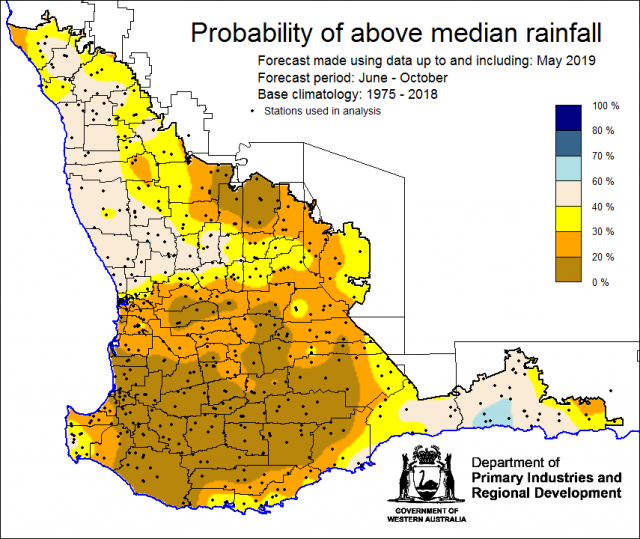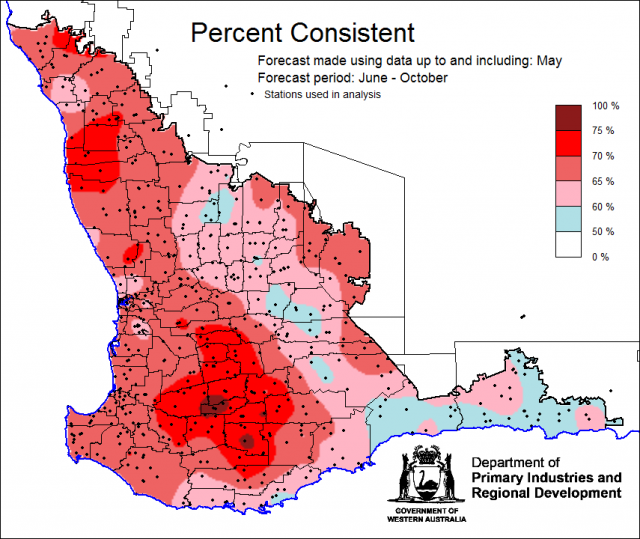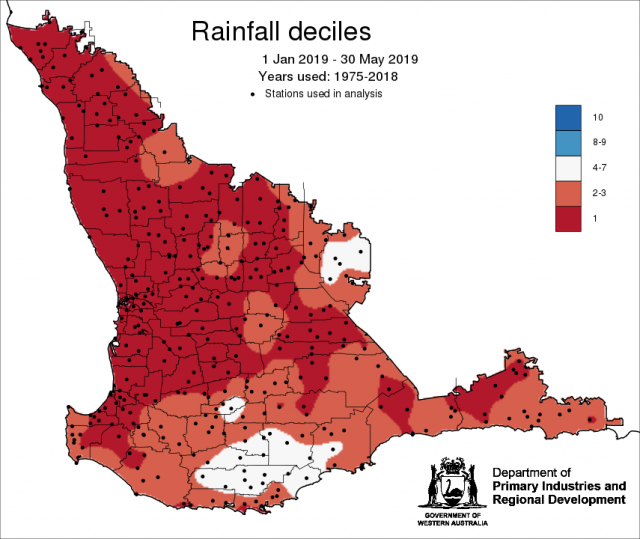SSF June to October outlook
The SSF is indicating less than 40% chance of exceeding median rainfall for June to October for the central wheatbelt, great southern, south coastal and south west (as classified by the Bureau of Meteorology forecast districts). For the central west and southeast coastal districts, SSF is indicating neutral (40-60%) chance of exceeding median rainfall. Most probable decile range is decile 2-3 for the central wheatbelt, great southern, south coastal and south west. Predictive skill based on May conditions is mostly poor to good (50 -75% consistent).


Recent climate
May rainfall was very much below average in the SWLD.May maximum temperatures were average to above average and minimum temperatures were very much below average. Rainfall since 1 January has been below decile 3 for the majority of the grainbelt.
In May, the atmospheric pressure was very much above normal over the SWLD, reducing rainfall across parts of southern Australia. The current state of the drivers means that higher than average pressure is likely over southern Australia for winter. This can act to keep cold fronts further south than normal, thereby reducing winter rainfall to the southern states.
The Indian Ocean sea surface temperatures off the western WA coastline have been cooler than average. The June to August SST forecast, by the Bureau of Meteorology indicates that SST in the Indian Ocean will be near normal north of WA.
The Southern Annular Mode (SAM), also known as the Antarctic Oscillation (AAO), describes the north–south movement of the westerly wind belt that circles Antarctica, dominating the middle to higher latitudes of the southern hemisphere. For May, SAM was near neutral and is expected to remain so for the next couple of months.
The current positive IOD value is being driven by warmer than average sea surface temperatures across most of the Indian Ocean basin, and closer to average temperatures in parts of the eastern node of the IOD, near the Indonesian island of Sumatra. For an event to be considered to have occurred, the IOD value needs to be above the threshold value for at least eight weeks. Climate outlooks indicate the IOD is likely to be positive from June through to November. A positive IOD typically means drier than average conditions for southern and central Australia during winter-spring. The dry years of 2006, 2012 and 2015 (2006 and 2015 were also El Niño years) were all positive IOD years.
The Bureau's ENSO Outlook is currently on El Niño WATCH. Models indicate the tropical Pacific Ocean will ease away from El Niño levels, becoming neutral during winter. For further information, see the Bureau of Meteorology’s ENSO Wrap Up.
The table below gives a summary of past month and three-month South West Land Division (SWLD) climate conditions, and can indicate what is likely to occur in the near future if climate conditions follow the current pattern.
| Climate Indicator | Past month | Past 3 months |
|---|---|---|
| SWLD Rainfall | Very much below average | Below average |
| SWLD Mean Temperature | Below average | Average |
| SWLD atmospheric pressure | Very much above normal | Above normal |
| Indian Ocean Sea surface temperature | Cooler | Cooler |
| El Niño/Southern Oscillation (ENSO) | Neutral | Neutral |
| Indian Ocean Dipole (IOD) | Neutral | Neutral |
| Southern Annular Mode (SAM) | Neutral | Neutral |

